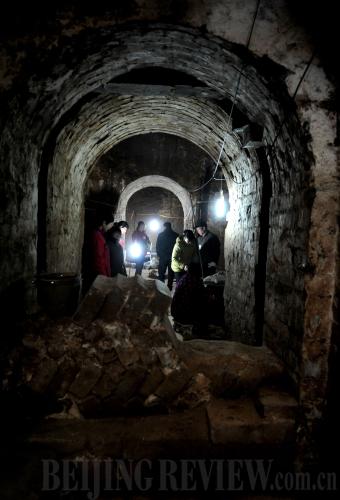|
 |
|
IMPORTANT ARTIFACTS: Part of the relics unearthed from the ancient tomb in Anyang, Henan (ZHU XIANG) |
No other archaeological finding in China has attracted more interest from the public than the discovery of the tomb of Cao Cao (155-220) at the end of 2009.
Cao was an important politician at the end of the Eastern Han Dynasty (25-220) and one of the key figures in the Three Kingdoms Period (220-280). The curiosity and the zeal of the public surrounding the finding might arise from well-known folklore that 72 tombs were built after Cao's death to deter grave robbers. For centuries, no one knew the real place where Cao rested in his afterlife.
The mystery seemed to be answered at the end of 2009. On December 27, the administration of cultural heritage in central China's Henan Province announced in Beijing that a group of tombs of the Eastern Han Dynasty unearthed by archaeologists in the province's Anyang County proved to be Cao's. The announcement soon sparked a debate in society about the authenticity of the evidence the administration presented.
The administration said the archaeologists made their conclusion based on a careful study on the structure of the mausoleum and the relics unearthed. Archaeologists said the tomb covered more than 740 square meters, which showed the body buried in the tomb was not an ordinary person, and very likely to be a king or emperor.
Around 250 items were unearthed from the tomb. Pan Weibin, head of the excavation team of the ancient tomb, said in the December 27 press conference that more important findings included a stone stele and a porcelain pillow, the inscriptions on which read, "Emperor Wu of the Kingdom of Wei," which showed the identity of the buried person, as it was the title given to Cao after his death.
Pan said archaeologists had also found segments of three head bones, one of a man and two of women. The bone of the man was verified as the bone of a man in his 60s, about the age Cao was when he died.
He also said that, among the unearthed relics, gold and silver items were few. This is rare for a tomb containing the remains of a king or an emperor, but tallies with historical records indicate that when Cao was alive, he advocated a simple burial system.
But many archaeologists and scholars doubt these proofs. Scholar Ni Fangliu said in a blog that the most important piece missing from the evidence was an epitaph for the dead.
Another questioner of the evidence's veracity, Yuan Jixi, an historian at Renmin University of China, said that the finding needed more forceful proof to make sure it was the tomb of Cao.
"Much proof is not first-hand, and so it is not very convincing," Yuan said in an article on Chinanews.com.cn. He said the tomb had been robbed many times in history, and not much credible proof had been left and also that he doubted one of the relics found in the tomb, part of a weapon said to be used by Cao. "Whether it is the real one is difficult to authenticate, as the tomb has been broken into many times and some items might have been put there by thieves deliberately."
On January 11, the public was hooked again by the debate when it was announced that the Institute of Archaeology of the Chinese Academy of Social Sciences (CASS), a leading institute for archaeological study in China, had sent a 12-person team of experts to Henan Province to research the ancient tomb. The public expected the experts to give a final conclusion.
On January 13, CASS held a forum in Beijing and said that based on current archaeological research, the unearthed ancient tomb in Anyang could be "primarily ascertained" to be Cao's. At the same time, CASS added the discovery of Cao's tomb to the list of China's six major archaeological findings in 2009.
But the experts also stressed that this was not the final conclusion. Wang Wei, Director of the CASS Institute of Archaeology, said that it was only the majority opinion of the experts and that it was still too early to say if the person buried in the tomb was Cao himself.
"The excavation of the tomb has just ended and the real study just begun. We also found another tomb near the excavated one, which also belongs to the Eastern Han Dynasty. We need to finish the excavation of that tomb and then study the findings. Only after the study of the two tombs can archaeologists come to a final conclusion," Wang said.
He also said that to academic circles, verifying whether the ancient tomb was Cao's is not the most important point. What was more important was that, because of the archaeological study, modern people would learn more about people's lives and social development of the time.
The CASS experts' opinion has seemed to put public debate over this archaeological discovery to an end, but archaeologists say it was also a real beginning in that China's public could learn more about the science and become eager to participate in archaeology.
 |
|
MYSTERIOUS TOMB: The arch door of the ancient tomb found in Anyang, Henan (ZHU XIANG) |
| 